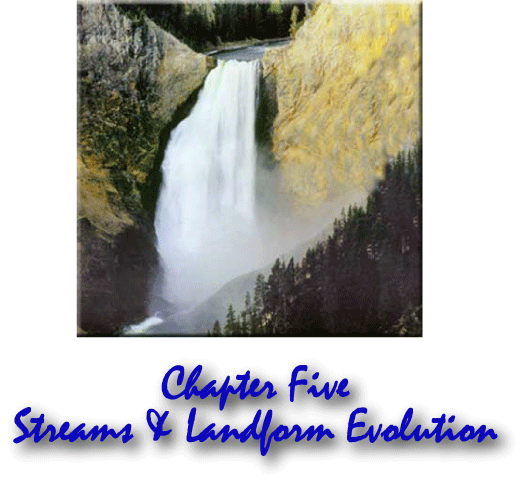
Editor's Note
Running
water on the earth's surface is the most significant agent shaping the
modern landscape. Most of this water is moving in channelized
flow in streams. To the geologist stream refers to all
channelized flow without regard to size. Common terms such as
river, creek, brook, etc. all refer to streams and all share common
behavior and are governed by the same set of physical laws.
The study of landscape evolution is a branch of the geosciences referred to as geomorphology (shape of the earth (land)). The study of geomorphology overlaps between the broader studies of Physical Geology and Physical Geography. These two areas of the geosciences converge in the study of both streams and the landscapes they erode. This chapter, as are other chapters dealing with landscape evolution, is drawn from the online Physical Geography Text Fundamentals of Physical Geography by Michael Pidwirny, Ph.D. of Okanagan University College. These readings are concise, but discuss the important aspects of both stream processes and their effect on the landscape.
The study of landscape evolution is a branch of the geosciences referred to as geomorphology (shape of the earth (land)). The study of geomorphology overlaps between the broader studies of Physical Geology and Physical Geography. These two areas of the geosciences converge in the study of both streams and the landscapes they erode. This chapter, as are other chapters dealing with landscape evolution, is drawn from the online Physical Geography Text Fundamentals of Physical Geography by Michael Pidwirny, Ph.D. of Okanagan University College. These readings are concise, but discuss the important aspects of both stream processes and their effect on the landscape.
PART
I
Streamflow and Stream Processes
from: Fundamentals of Physical Geography
Michael Pidwirny
Okanogan University College
http://www.physicalgeography.net/fundamentals/10y.html
Streamflow and Stream Processes
from: Fundamentals of Physical Geography
Michael Pidwirny
Okanogan University College
http://www.physicalgeography.net/fundamentals/10y.html
[ENTER] [Review this Resource]
PART
II
Fluvial Landforms
from: Fundamentals of Physical Geography
Michael Pidwirny
Okanogan University College
http://www.physicalgeography.net/fundamentals/10z.html
Fluvial Landforms
from: Fundamentals of Physical Geography
Michael Pidwirny
Okanogan University College
http://www.physicalgeography.net/fundamentals/10z.html
[ENTER] [Review this Resource]
PART
III
The Drainage Basin Concept
from: Fundamentals of Physical Geography
Michael Pidwirny
Okanogan University College
http://www.physicalgeography.net/fundamentals/10aa.html
The Drainage Basin Concept
from: Fundamentals of Physical Geography
Michael Pidwirny
Okanogan University College
http://www.physicalgeography.net/fundamentals/10aa.html
[ENTER] [Review this Resource]
PART
IV
Stream Morphometry
from: Fundamentals of Physical Geography
Michael Pidwirny
Okanogan University College
http://www.physicalgeography.net/fundamentals/10ab.html
Stream Morphometry
from: Fundamentals of Physical Geography
Michael Pidwirny
Okanogan University College
http://www.physicalgeography.net/fundamentals/10ab.html
[ENTER] [Review this Resource]
